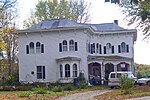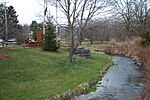Innisfree Garden

Innisfree Garden is an American nonprofit public garden influenced by Chinese style in Millbrook, New York. The garden was established between 1930 and 1960 as the private garden of Walter and Marion Beck, inspired by scroll paintings of the 8th-century Chinese poet and painter Wang Wei. With the help of landscape architect Lester Collins from Harvard University, individual garden scenes inspired by the Chinese paintings were connected to an overall landscape around a glacial lake, in keeping with the ecological surroundings. From 1960, the garden was managed by a foundation headed by Collins, and open to the public. It was listed on the National Register of Historic Places in Dutchess County in 2019.
Excerpt from the Wikipedia article Innisfree Garden (License: CC BY-SA 3.0, Authors, Images).Innisfree Garden
Tyrrel Road,
Geographical coordinates (GPS) Address Phone number Website External links Nearby Places Show on map
Geographical coordinates (GPS)
| Latitude | Longitude |
|---|---|
| N 41.758333333333 ° | E -73.75 ° |
Address
Innisfree Garden
Tyrrel Road 362
12545
New York, United States
Open on Google Maps









